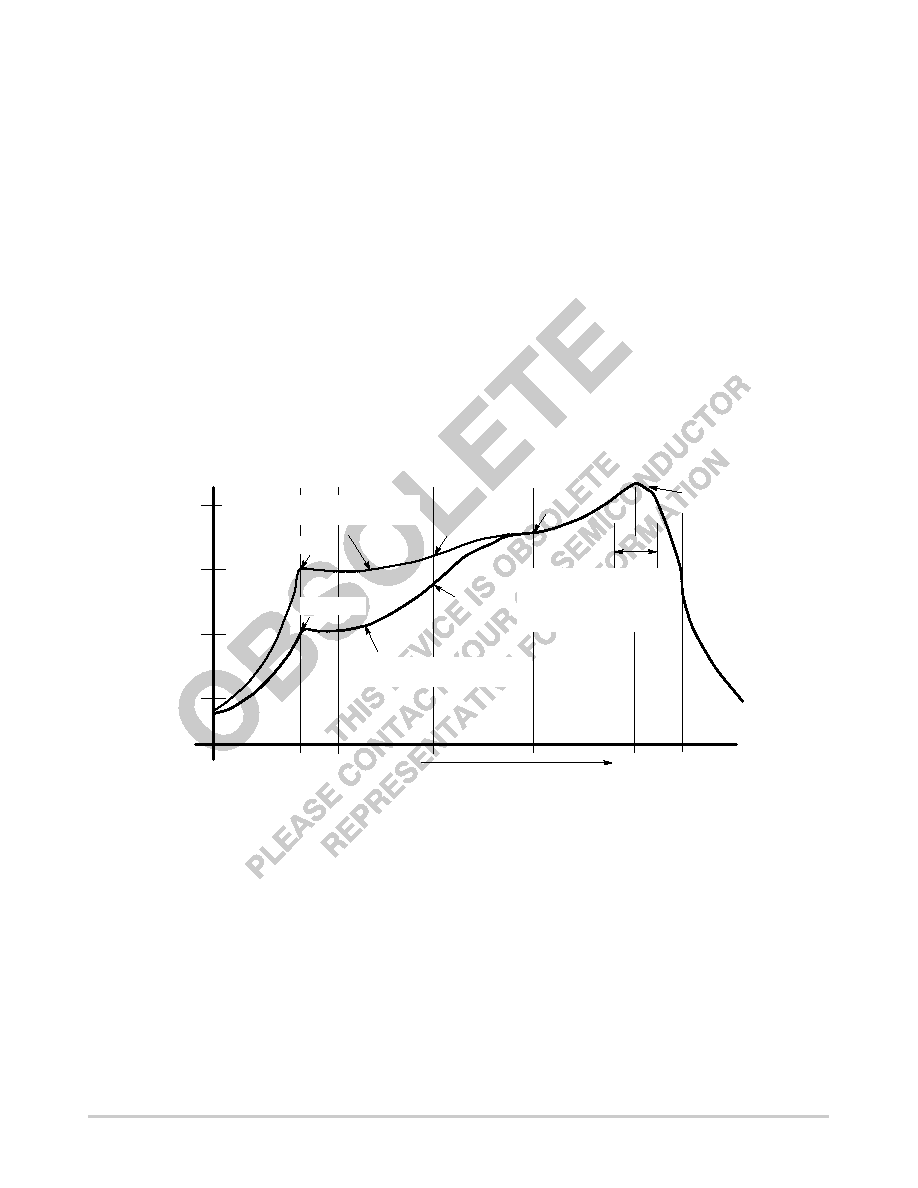- 您现在的位置:买卖IC网 > PDF目录98046 > MTD3302 (ON SEMICONDUCTOR) 8300 mA, 30 V, N-CHANNEL, Si, SMALL SIGNAL, MOSFET PDF资料下载
参数资料
| 型号: | MTD3302 |
| 厂商: | ON SEMICONDUCTOR |
| 元件分类: | 小信号晶体管 |
| 英文描述: | 8300 mA, 30 V, N-CHANNEL, Si, SMALL SIGNAL, MOSFET |
| 封装: | DPAK-3 |
| 文件页数: | 3/12页 |
| 文件大小: | 278K |
| 代理商: | MTD3302 |

MTD3302
http://onsemi.com
11
TYPICAL SOLDER HEATING PROFILE
For any given circuit board, there will be a group of
control settings that will give the desired heat pattern. The
operator must set temperatures for several heating zones
and a figure for belt speed. Taken together, these control
settings make up a heating “profile” for that particular
circuit board. On machines controlled by a computer, the
computer remembers these profiles from one operating
session to the next. Figure 20 shows a typical heating
profile for use when soldering a surface mount device to a
printed circuit board. This profile will vary among
soldering systems, but it is a good starting point. Factors
that can affect the profile include the type of soldering
system in use, density and types of components on the
board, type of solder used, and the type of board or
substrate material being used. This profile shows
temperature versus time. The line on the graph shows the
actual temperature that might be experienced on the surface
of a test board at or near a central solder joint. The two
profiles are based on a high density and a low density
board. The Vitronics SMD310 convection/infrared reflow
soldering system was used to generate this profile. The type
of solder used was 62/36/2 Tin Lead Silver with a melting
point between 177 189
°C. When this type of furnace is
used for solder reflow work, the circuit boards and solder
joints tend to heat first. The components on the board are
then heated by conduction. The circuit board, because it has
a large surface area, absorbs the thermal energy more
efficiently, then distributes this energy to the components.
Because of this effect, the main body of a component may
be up to 30 degrees cooler than the adjacent solder joints.
STEP 1
PREHEAT
ZONE 1
“RAMP”
STEP 2
VENT
“SOAK”
STEP 3
HEATING
ZONES 2 & 5
“RAMP”
STEP 4
HEATING
ZONES 3 & 6
“SOAK”
STEP 5
HEATING
ZONES 4 & 7
“SPIKE”
STEP 6
VENT
STEP 7
COOLING
200
°C
150
°C
100
°C
5
°C
TIME (3 TO 7 MINUTES TOTAL)
TMAX
SOLDER IS LIQUID FOR
40 TO 80 SECONDS
(DEPENDING ON
MASS OF ASSEMBLY)
205
° TO 219°C
PEAK AT
SOLDER
JOINT
DESIRED CURVE FOR LOW
MASS ASSEMBLIES
DESIRED CURVE FOR HIGH
MASS ASSEMBLIES
100
°C
150
°C
160
°C
170
°C
140
°C
Figure 20. Typical Solder Heating Profile
相关PDF资料 |
PDF描述 |
|---|---|
| MTD4N20E | 4 A, 200 V, 1.2 ohm, N-CHANNEL, Si, POWER, MOSFET |
| MTD4N20E1 | 4 A, 200 V, 1.2 ohm, N-CHANNEL, Si, POWER, MOSFET |
| MTD4N20E-1 | 4 A, 200 V, 1.2 ohm, N-CHANNEL, Si, POWER, MOSFET |
| MTD9N10ET4 | 9 A, 100 V, 0.25 ohm, N-CHANNEL, Si, POWER, MOSFET |
| MTD9N10E | 9 A, 100 V, 0.25 ohm, N-CHANNEL, Si, POWER, MOSFET |
相关代理商/技术参数 |
参数描述 |
|---|---|
| MTD3302T4 | 制造商:ON Semiconductor 功能描述:Trans MOSFET N-CH 30V 30A 3-Pin(2+Tab) DPAK T/R 制造商:Rochester Electronics LLC 功能描述:- Bulk 制造商:ON Semiconductor 功能描述:MOSFET Transistor, N-Channel, TO-252AA |
| MTD3610D3 | 功能描述:Photodiode 940nm 制造商:marktech optoelectronics 系列:- 包装:散装 零件状态:有效 波长:940nm 颜色 - 增强:- 频谱范围:400nm ~ 1060nm 二极管类型:- 不同 nm 时的响应度:0.45 A/W @ 660nm 响应时间:- 电压 - DC 反向(Vr)(最大值):20V 电流 - 暗(典型值):10nA 有效面积:- 视角:- 工作温度:-20°C ~ 85°C 安装类型:- 封装/外壳:- 标准包装:10 |
| MTD392 | 制造商:未知厂家 制造商全称:未知厂家 功能描述:Coaxial Transceiver Interface |
| MTD392N | 制造商:未知厂家 制造商全称:未知厂家 功能描述:Coaxial Transceiver Interface |
| MTD392V | 制造商:未知厂家 制造商全称:未知厂家 功能描述:Coaxial Transceiver Interface |
发布紧急采购,3分钟左右您将得到回复。